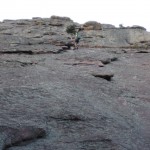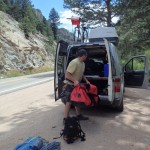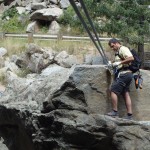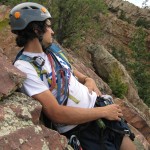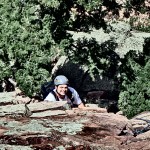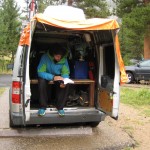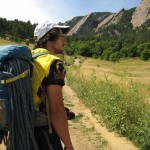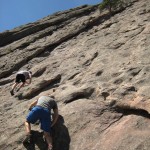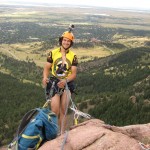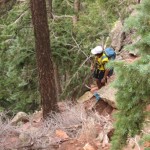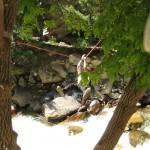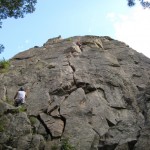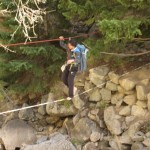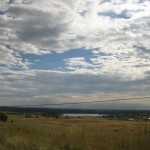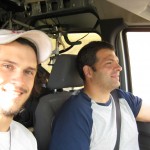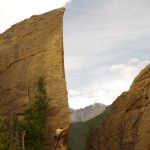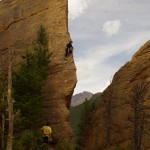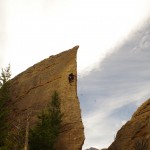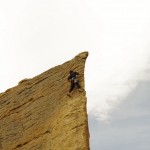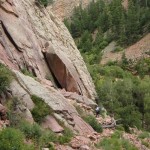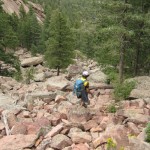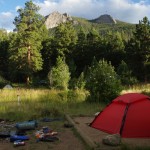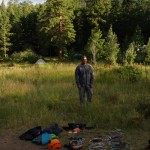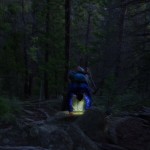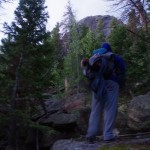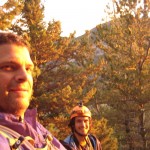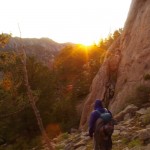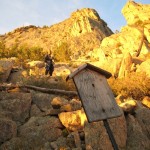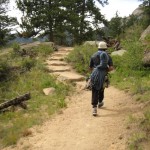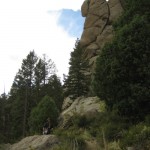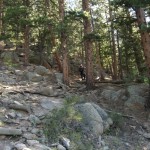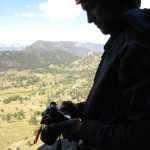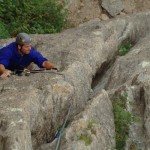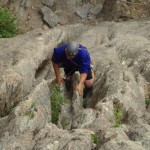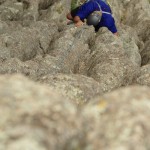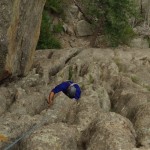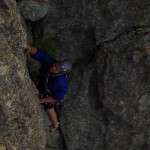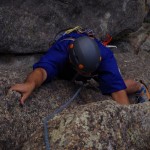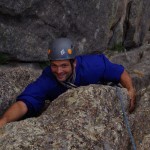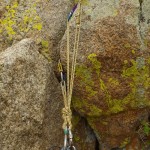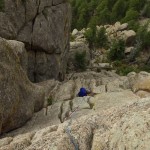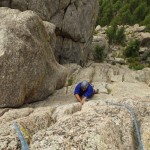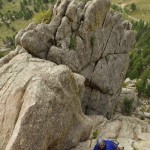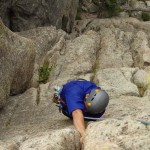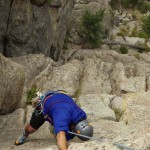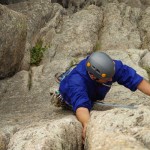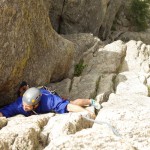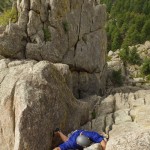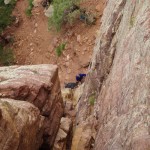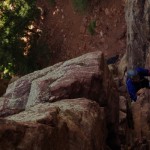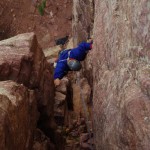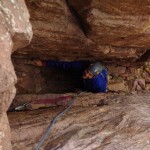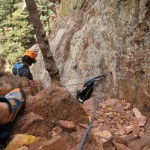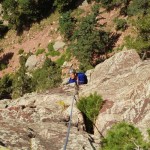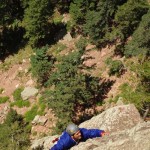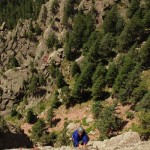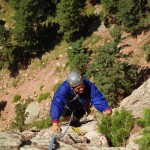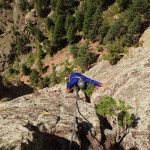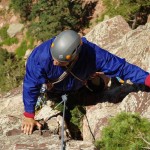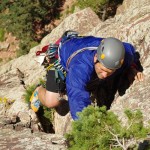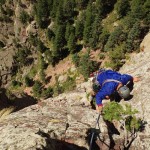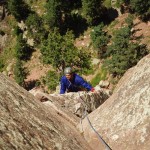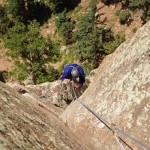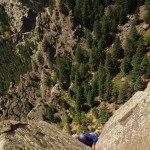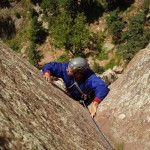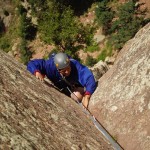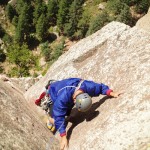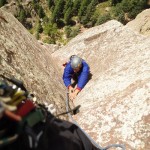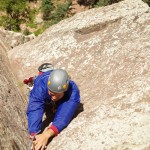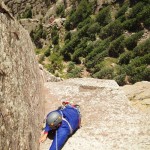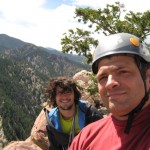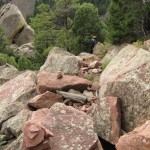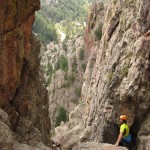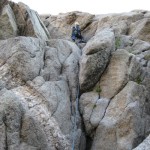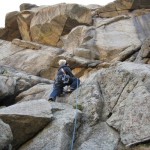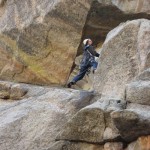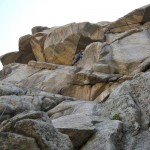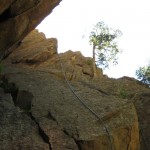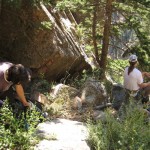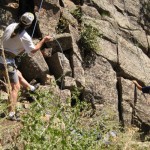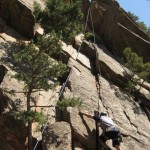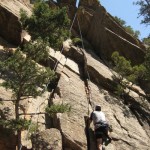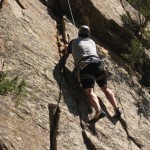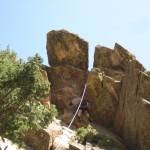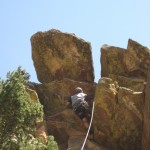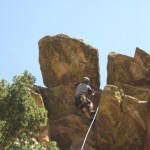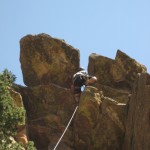This post presents a gallery of ALL images in this series. You can click on any to enlarge; you can even click on the first, sit back, and it’ll run them all as a slide show. The gallery is dynamic so it will automatically grow as I add more posts to this series.
Scree
noun : an accumulation of loose stones or rocky debris lying on a slope or at the base of a hill or cliff.
Visceral
My suspicion is that, in our convenient society, we don’t need to be acutely aware of our balance and body positions vis a vis the ground because many of us don’t do much physical labor anymore, or play freely as kids outdoors now that we have so many enticing computer games to entertain us.
~ Wayne Muromoto from, 90. The base: close to the ground – The Classic Budoka
slip:4uwote2.
More than a year ago, I wrote that parkour is about freedom (and much more.) There is also a visceral component that I’m finding is playing a greater and greater role.
Visceral, adj. characterized by, or proceeding from, instinct rather than intellect: a visceral reaction; characterized by, or dealing with, coarse or base emotions.
When you treat your body like a Cadillac meat vehicle – that is, when it’s just a mode of conveyance from one creature-comfort to the next – you soon cease to be intimately aware of what your body is feeling. A large part of the allure of parkour is the immediate and clear, honesty and reality of the experience of training. It’s obvious that your body and mind are not readily separable, but in normal daily life, one mostly ignores the body. In parkour, the body and mind have to work in harmony.
I have a lot more to say about this harmony (my personal interpretation, and explanation, thereof.) But for the moment, I’m just going to start with the above.
ɕ
The weight of the past
This is not to say that nostalgia is our inescapable fate. The lesson I am trying to draw from reflecting on the examples of Snowden and the N.F.L. is not that the thrill ends early. Rather, in their extremity these examples bring out something else. For most of us, as our lives unfold we simply do not, we cannot, know whether we have peaked in an area of our lives — or in our lives themselves — in ways that are most important to us. The past weighs upon us, not because it must cancel the future, but because it is of uncertain heft.
~ Todd May from, The Weight of the Past – The New York Times
slip:4unyte1.
ɕ
The over justification effect
Self-perception theory says you observe your own behavior and then, after the fact, make up a story to explain it. That story is sometimes close to the truth, and sometimes it is just something nice that makes you feel better about being a person.
~ David McRaney from, The Overjustification Effect – You Are Not So Smart
slip:4uyote1.
ɕ
A most sincere thank you
Two years ago today, I showed up at Wescosville Elementary at 4pm and tried parkour. A very big thank you to everyone ( Adam, Josh, Joseph, and Miguel in particular) who has been friendly, happy, and encouraging these last two years. This week I will be attempting the ADAPT 1 certification; I could not have accomplished what I have without all the help from the wonderful men and women of lehigh valley parkour. “allez, allez!”
ɕ
A deep sense of malaise
You can harness and channel these needs, but a man completely ignores them at his peril. Modern men are told there’s nothing real about manhood — that it’s all a silly, outdated cultural construct — and they sure work hard to believe it. And yet they cannot shake a deep sense of malaise, and they don’t know why.
~ Brett McKay from, Where Does Manhood Come From? | The Art of Manliness
slip:4uaowe1.
I consider myself very lucky. I’m expressing my mid-life crisis in some pretty healthy and productive ways. Instead of going on a more traditional bender, I’m shaking off shackles and bindings that I in fact put on.
One day I realized that there is no longer anyone left to tell me what to do. Certainly one has responsibilities, but there are precious few of those which are immutable bedrock. You look at your life and think, “Look at all these ideas I’ve accepted.” When you pick idly at some of the threads, the whole thing comes apart, and you find yourself in a row boat on the sea — or on a bicycle on the open road (choose your own metaphor). On the open sea in a good way; You realize you are free, that in fact you have NOT always been free, and that there’s an awful lot of life left to live now that you’re ready to start.
ɕ
First successful Turing Test
First successful Turing Test: First Turing Test success marks milestone in computing history
ɕ
June 6th, 2014
Today is the 70th anniversary of the landings for the Normandy invasion.
A friend asked rhetorically, “Would I have boarded one of those ratty boats and waited for the door to come down?” I can only imagine that the training and “esprit de corps” would carry the day, because otherwise, attempted as individuals, what they accomplished seems inconceivable.
Unfortunately, those two most horrible wars feel as far away now as to be ancient history. I hope that humankind has subsequently climbed far enough up the moral ladder that we no longer need the visceral feeling of the wars to provide us with guidance.
ɕ
Finding meaning in the mundane
Everyone here has done this, of course. But it hasn’t yet been part of you graduates’ actual life routine, day after week after month after year.
But it will be. And many more dreary, annoying, seemingly meaningless routines besides. But that is not the point. The point is that petty, frustrating crap like this is exactly where the work of choosing is gonna come in.
~ David Foster Wallace
slip:4a799.
It occurs to me that I’ve no idea who gave the commencement address at my graduation. After a bit of digging…
Robert W. Galvin, chairman of Motorola, delivered the main address yesterday to the 1,150 graduates at the 125th commencement of Lehigh University in Bethlehem, Pa.
Mr. Galvin received an honorary Doctor of Engineering degree.
~ from the May 31st NYT archives listing several school’s commencement addresses.
ɕ
Take back the Internet
This is not the Internet the world needs, or the Internet its creators envisioned. We need to take it back.
And by we, I mean the engineering community.
Yes, this is primarily a political problem, a policy matter that requires political intervention.
But this is also an engineering problem, and there are several things engineers can — and should — do.
~ Bruce Schneir from, Take Back the Internet
slip:4usebo4.
I’d venture that the vast majority of regular, everyday people working in technology related jobs are not actively trying to do evil. People go to work, make the best decisions they can and then go home. If that’s true, then it’s going to be nigh impossible to change the momentum of how things (e.g., NSA surveillance) are going. Because in order for it to change, we need to start thinking bigger.
ɕ
Oil limits
This model “works” fairly well, as long as the economy is growing fast enough–population continues to grow and resource extraction continues to grow as planned. In a finite world, we know that this model cannot work forever. At some point, we can expect to start reaching limits.
What do these limits look like? I would argue that in the case of resource extraction, these limits look like increasingly high cost of extraction.
~ Gail Tverberg from, Oil Limits Reduce GDP Growth; Unwinding QE a Problem
slip:4uouoi4.
You should also read “Quantitative Easing (QE)” (the first three, short paragraphs on WikiPedia summarize it neatly.)
My opinion: We need to start seriously talking about a STEADY STATE ECONOMY. What would that look like? How would it work? How do we get to that? Seriously. We simply CANNOT have a growing and expanding economy forever on a finite planet with finite room and finite resources. What part of “finite” don’t you understand?
ɕ
What does “honest” mean in Kinokawa Aikido
When we opened the new dojo in Allentown, I sat down to try to write a short description of what distinguishes Kinokawa Aikido. I wanted to avoid pretentiously explaining “what makes it better,” because starting down that path will instantly close off the minds of certain readers. Instead, I wanted to lay out the hallmarks of Kinokawa so that readers could get a sense of the style at a glance.
There is a bit more at Aikido on the dojo’s web site. But here is the part about honesty:
A second hallmark of Kinokawa Aikido is that is honest — in the sense of being interested in honestly exploring Aikido as a high intensity [physical and mental], combat effective, applicable to your daily life, sort of practice. In fairness, practitioners of hard type martial arts will generally not consider any sort of Aikido as combat effective or workable in a real world scenario. (Obviously, we disagree with such a prejudged assessment.) But setting aside the judgement (does Aikido work, or not, in real application?), it is the goal of honestly exploring those concepts, within the framework of Aikido, which is a critical feature of Kinokawa.
…and here are some similar thoughts from Tom Collings, from Responding to Aggression – Part 2:
… The rule of thumb in military and police training, established through exhaustive battlefield and police critical incident research is: “if it takes long to learn, it probably won’t work under stress.” Yet, as black belt martial artists we take great pride in the techniques that took us many years to master, and it would be unthinkable at the dojo to teach only what is easily learned. Who would that impress? The other rule is: “practice what you will need to perform.” That means our training must very closely match what we will confront.
Do those of us in the aiki arts really believe that assaults commonly occur by someone running up reaching for our wrist, or striking at us from above their head as if holding a sword? I guess we do because we devote most of our valuable training time to these scenarios. If it is obvious that modern day assaults are very different from these classical style attacks why do we not modify our curriculum more in line with what we will actually confront?
ɕ
To be and to last

To last? That old lesson about the brightest flame burning the quickest is particularly true in Parkour. What use is a person who lasts five years and has to stop training due to bad knees and a broken ankle? How useful is a body that can’t move pain free due to years of neglect and abuse? The journey of Parkour was never meant to be a brilliant flash of spectacle and show, it was always intended to be a lifelong pursuit of improvement and one that doesn’t need to end once the body begins to show signs of age.
~ Chris “Blane” Rowat from, 50 Ways To Be and To Last in Parkour | Part 1 – Training The Body
slip:4ubowa1.
Ignore the show reels. Ignore the spectacular. Those MAY be inspirational to you, but your journey SHOULD be a long series of small, eminently POSSIBLE steps. Go to your first class and try anything; try SOMETHING. Stop when your body has had enough. Repeat. In a few months, you will have grown so much that you will hardly recognize yourself.
ɕ
Operable systems
Especially for complex, multi-purpose systems, the gap between how things are supposed to work and how they actually work can be quite large. (Ask any police sergeant about the difference between policing in theory and policing in practice!) A primary function of operators is to bridge this gap in ways that result in better rather than worse outcomes. The capacity of systems to be operated is what allows operators to perform this valuable function, sometimes called technical work.
~ Richard Cook from, «http://programming.oreilly.com/2013/10/making-systems-operable.html»
slip:4uoema1.
More and more I’ve been getting a lot mileage from this idea: Make things easier TO USE, rather than trying to fully automate (i.e., so I don’t have to use them.) One cornerstone to accomplishing that is creating “affordences“.
ɕ
First habitable exoplanet
The first Earth-sized exoplanet orbiting within the habitable zone of another star has been confirmed by observations with both the W. M. Keck Observatory and the Gemini Observatory. The initial discovery, made by NASA’s Kepler Space Telescope, is one of a handful of smaller planets found by Kepler and verified using large ground-based telescopes. It also confirms that Earth-sized planets do exist in the habitable zone of other stars.
~ from, First potentially habitable Earth-sized planet confirmed: It may have liquid water
Mark you calendar: April 17, 2014. First confirmation of the existence of a HABITABLE planet… Temperature, gravity, rocky (like the Earth)… A. HABITABLE. PLANET. I got chills reading this.
ɕ
Sheep or sheepdog?
So the first step in becoming a sheepdog is to simply decide to become one. Don’t take this decision lightly. There are heavy moral, physical, emotional, and psychological costs that come with it. When you decide to become a sheepdog, you’re also deciding to live a life of service to your fellow man, to run to danger when others flee, and to stand up for right despite the cost. Are you ready to accept those responsibilities and risks, and the consequences that come with them?
~ Brett McKay from, Are You a Sheep or Sheepdog? Part III: Your Roadmap to Becoming a Sheepdog
slip:4uaoae1.
Disclosure: I do NOT think of myself as a “sheepdog”.
I think the whole “sheep versus sheepdog” mentality discussion is much more useful in so far as it speaks to enlightening the sheep. Are you a victim going somewhere to happen? …or are you a mentally strong, open minded (in the sense of being flexible to your environment) human being? Are you seeking and buying things? …or are you seeking happiness?
ɕ
Hello App.net
![]()
App.net is WAY cool
What makes it cool, different and BETTER is:
- They built the PLATFORM, (the heavy lifting behind-the-scenes that makes it all work)
- They wrote the API, (the instructions for how to build things to USE the platform)
…and that’s all they wrote.
Aside: Yes, they did write sample applications. It’s hard enough to wrap your brain around it as it is, let alone if there were no apps to play with. So they built a web-based front end called “Alpha”, (for example.)
You, (dear reader) do not “look at” App.net, and you do not “use it”. You use APPLICATIONS which are built on the App.net platform/API.
App.net is different
App.net charges the developers: They’ve built a stable, powerful and feature-rich PLATFORM. They logically believe that developers will be willing to pay to use the platform.
Developers build applications: They pay App.net for access to connect their application to the platform. For example: Tapbot’s Netbot app is a superlative app using the platform. (App.net also maintains a directory of available apps.)
People use the applications: You, dear reader, choose your favorite application. You can use the free “Alpha”, (that’s it’s name) web front-end that App.net wrote. You can also download an app, (some are even free) from your favorite app store for your mobile device.
So, for example, how do you find me on App.net? Easy: Open your favorite App.net application and look for “cc1315”, my full name, or my email address. If you like to use the “Alpha” web-based application, then I’m /cc1315 . So there’s you using an App.net application! Another example is the application I wrote, (it required three mouse clicks) which enables this blog to push my posts into the App.net platform.
Wait. Wat?
The problem with all the big-name social networks is that they built, own and control the platform AND the application.
By “problem” I mean “things regular-users don’t like.” For example: Ads appearing; Weird algorithms that determine what I actually see and which strong-arm content-creators into paying money to boost viewership; Posts that look like posts but are really ads paid for by advertisers. And things that limit content creators, like: Not allowing posts at all into the platform; Weird rules that limit how posting is done because they don’t want the users leaving the platform to go read content directly.
This is exactly WHAT WE DESERVE. The companies that built the platforms get to create the rules because they own the platform, control the API and they control the applications. The people USING the social network are the product that gets monetized. So everyone shows up, for free, to socialize. But then the advertisers buy-in to get access to all the people. To the people socializing, it feels like the social club is letting weirdos into the club who roam around asking if we want to buy things.
Don’t believe me? Here are some search-result links:
“why Facebook sucks”
“why Twitter sucks”
“why Pinterest sucks”
“why Instagram sucks”
App.net fixes this how?
Let’s think through the “problem” scenarios…
First, you do still choose who to follow. So let’s assume for this discussion I’m following a couple hundred accounts. (My friends, some favorite businesses, etc)
ads
I see a post from a business, but it’s actually an ad! …how do I make that go away? Current social networks? …you cannot.
Aside: Yes, some social networks let you kill that particular ad, but there are always more to follow. In reality, you’re just TUNING what ads they will show you, not blocking out ads.
With App.net it’s easy: Stop following that account. (Or maybe contact them and say, “yo, less ads please” if you really like their other posts.) App.net won’t let them send you further content, that would be a lousy platform that developers wouldn’t pay to use!
So maybe that ad you see is being shown by the application you’re using… it’s not really coming through the App.net platform… Easy: Don’t use that application. Or maybe pay them to turn the ads off. (Look! An application ecosystem where great apps win out.)
But, (you ask) what If someone tries to write an app to spam ads into the App.net platform? It turns out the platform doesn’t have that ability. (The current social networks have that ability BIG TIME — it’s how they make money.) But App.net makes money from the developers, so they don’t have a “spam everyone” feature in the platform. That’d be a lousy platform that developers would not pay to use.
content filtering
App.net delivers everything from all the accounts you’re following; That’s why developers want to pay to use the platform; It works well! So the applications might filter, or sort, or whatever. (Maybe, show me more posts from my friends whose posts I favorite.) But that’s a feature that you CHOOSE when you select what app to use. Don’t like how the app filters or sorts? …switch apps!
content posting into the platform
Current social networks want you to use their apps to post content. App.net simply moves the content through the platform. (Which is why it’s a great platform that developers want to pay to use.) So anyone can write any application to post content into the network.
Closing thought
The only thing more cool (in social networking) than App.net is Tent.io . With Tent.io, instead of having one centralized platform like current social networks and even App.net, you have one giant fabric which is composed of everyone’s PERSONAL data platform. So Craig’s posts are on Craig’s platform, etc. Then the Tent.io magic moves the messages around between the nodes, prevents anyone from impersonating anyone else, etc.
But that’s another post altogether… :*)
ɕ
Heartbleed: For want of one nail, the kingdom is lost
The Heartbleed OpenSSL problem is big news ( http://heartbleed.com if you’ve been under a rock ). What’s wrong?
In short, Heartbeat allows one endpoint to go “I’m sending you some data, echo it back to me”. It supports up to 64 KiB. You send both a length figure and the data itself. Unfortunately, if you use the length figure to claim “I’m sending 64 KiB of data” (for example) and then only actually send, say, one byte, OpenSSL would send you back your one byte — plus 64 KiB minus one byte of other data from RAM.
Whoops!
~ Matt Nordhoff from, How exactly does the OpenSSL TLS heartbeat (Heartbleed) exploit work?
So this one, tiny-looking problem brings our entire sand-castle Internet kingdom down. “Secure” web sites turn out aren’t necessarily secure. Worse, they haven’t been secure for some uncertain amount of time. So, anything communicated insecurely, during some uncertain time-frame… is, uh, possibly snooped, stolen, etc. The system admins have to patch the fix in, then redo site certificates, then everything everyone has put to/from those sites, (your login and password for example!) has to all be considered stolen/tainted and has to be reentered.
Bonus: it’s even worse than I’m making it sound: Try this on…
ɕ
Also, people didn’t know to click on images
I distinctly remember:
- When inlining of images happened; The first time it was possible to put an image directly INTO the page. And JPEGs man. JPEGs where coooooooooool.
- Also, tables. Today, everyone loves to whine about how bad it is to use tables to layout pages. NOT having tables was much, much worse.
- And image-maps; The idea that WHERE exactly you clicked on an image, could take you to different content. I won’t even get into what we had to do to make it work… (but it involved: convex polygon mathematics, C code, a compiler, and a DEC Alpha work station.)
- …and we had to TELL people, “A lot of images in Skew are links… Click at will!” when we started e-publishing a magazine in December 1994.
So yeah, back in the day we had Mosaic. Then these guys hit it out of the park with:
Navigator was the way millions of people around the world were introduced to the web. Many web technologies and standards, such as as SSL, Java, Javascript, open APIs and support for online media, were innovations that Navigator made mainstream.
slip:4uieoe1.
ɕ

Vault box build
These plans are for building a vault box. This is not easy. You’ll need some good circular saw skills, patience and a lot of labor. Read on!
The original, in case you have a hardcopy, is online at
http://constantine.name/vault-box-build/
Drop me an email: Comments, questions, and suggestions for improvements are welcome. Best of all would be if you sent me some photos of what you built, preferably a big group photo of you on them, or using them or whatever. My email is my first name, craig, at this domain. (Yes, this is a “.name” domain.)
(The original design of this project is still available at, How NOT to build a vault box.)












